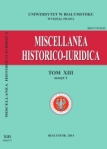El derecho real y las universidades españolas en el siglo XVIII
The royal laws and the Spanish universities in the XVIIIth century
Author(s): Belinda Rodríguez ArrochaSubject(s): Law, Constitution, Jurisprudence, History of Law, Higher Education , 18th Century
Published by: Wydawnictwo Uniwersytetu w Białymstoku
Keywords: Canon law; handbooks; Roman law; Royal law; Universities;
Summary/Abstract: During the Early Modern Age the study of Roman and canon law was undoubtedly an important fact in the Spanish universities. However, the instruction in the Castilian laws – like the Siete Partidas or the Nueva Recopilacion – was a gap in the academic curriculum in law faculties. Several scholars learned the legal procedure and the “national” laws on their own – reading legal handbooks, practice treatises or dictionaries. In the eighteenth century the establishment of Chairs in royal laws was taught in some important centers for legal studies like Valladolid, Salamanca and Alcala´. In 1771 Igna- cio Jorda´n de Asso and Miguel de Manuel Rodriguez published the first edition of their work Instituciones del Derecho civil de Castilla, a well-known handbook that also contained the Aragonese civil law. The reforms in the curriculum had a royalist purpose at the expense of Roman law and the papal power. At the same time, the renewal was necessary because the contents of the courses in universities were not suitable for the practice of justice before the various courts. Although some regulatory provisions tried to effect the transformation of legal studies since 1713, the establishment of native law teaching occurred under the reign of Charles III, a considerable delay. The purpose of this paper is the analysis of the transformations of legal education in Spain during the second half of that century.
Journal: Miscellanea Historico-Iuridica
- Issue Year: 13/2014
- Issue No: 2(1)
- Page Range: 97-116
- Page Count: 20
- Language: Spanish

